Exhibitions
2015-1 MOMAT Collection
Date
-Location
Collection Gallery, from the fourth to second floors
A special display : “What Are You Fighting For? (4th–2nd floor)
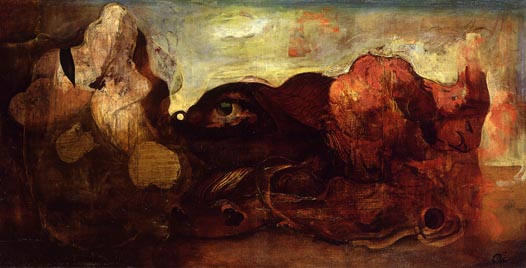
In this edition of the exhibit, we present “What Are You Fighting For?”, beginning on the fourth floor and continuing down to the second floor of the museum. This year marks the 70th anniversary of the end of World War II. Here, we present approximately 200 works that are meant to inspire thought about “fighting,” including conflicts between animals, nations, men and women, and those from different generations.
The title is derived from “Taga tame ni” (For Whom), the theme song of an animated TV show called 009 Cyborg (1979-1980, second season), which was based on a story by Ishinomori Shotaro. A serialized manga of the same name (which began in 1964) centers on nine humans, who are turned into cyborgs by Black Ghost, an evil organization that has continuously profited from war. The cyborgs rebel against the group and attempt to annihilate it in order to achieve peace. In this paradoxical effort to fight for peace, it gradually becomes clear that Black Ghost’s hidden drive is actually the human desire to wage war. The words to “Taga tame ni” were also penned by Ishinomori and both these lyrics and the story present us with important questions in 2015.
List of Works
- 展示内容、開館日・開館時間の変更の可能性がございます。詳細はハローダイヤル(03-5777-8600)にてご確認願います。
- 原則として各室ごとに国内作家(姓)50音順、外国人作家(姓)アルファベット順、同一作家内は、ほぼ作品の制作年順。
- Please note that the exhibits and the exhibition schedule are subject to change without previous notice. For up-to-date information, please kindly check our website.
| 展示場所(Shown on/at; Room No.) | 重文(Important Cultural Property) | 会期(Phase of the exhibit) | 音声ガイド(Audio Guide) | 作家名 | 題名 | 制作年 (Year of Produc- tion; c.= ~年頃) | 技法・支持体 | 収蔵経緯、寄贈、寄託(Mode of acquisition; Long term loan) | Name of the Artist | Title (in English) | Material (technique, support) |
|---|---|---|---|---|---|---|---|---|---|---|---|
| 4F (Fourth floor) | |||||||||||
| 1室 | 12 | 荻原守衛 | 女 | 1910 | ブロンズ | 文部省管理換 | OGIWARA, Morie | Woman | bronze | ||
| 1室 | 47 | 川端龍子 | 草炎 | 1930 | 絹本彩色 | 文化庁管理換 | KAWABATA, Ryushi | Flaming Grass | color on silk | ||
| 1室 | ◎ | 岸田劉生 | 道路と土手と塀 (切通之写生) | 1915 | 油彩・板 | 文化庁管理換 | KISHIDA, Ryusei | Road Cut through a Hill | oil on board | ||
| 1室 | 40 | 古賀春江 | 海 | 1929 | 油彩・キャンバス | 購入 | KOGA, Harue | Sea | oil on canvas | ||
| 1室 | 27 | 関根正二 | 三星(さんせい) | 1919 | 油彩・キャンバス | 購入 | SEKINE, Shoji | Three Stars | oil on canvas | ||
| 1室 | 18 | 土田麦僊 | 島の女 | 1912 | 絹本彩色 | 文部省管理換 | TSUCHIDA, Bakusen | Island Women | color on silk | ||
| 1室 | ◎ | 1 | 原田直次郎 | 騎龍観音 | 1890 | 油彩・キャンバス | 寄託(護國寺蔵) | HARADA, Naojiro | Kannon Bodhisattva Riding the Dragon | oil on canvas | |
| 1室 | 21 | 村山槐多 | バラと少女 | 1917 | 油彩・キャンバス | 山本孝氏寄贈 | MURAYAMA, Kaita | Roses and a Girl | oil on canvas | ||
| 1室 | 萬鉄五郎 | 太陽の麦畑 | c.1913 | 油彩・板 | 購入 | YOROZU, Tetsugoro | A Cornfield in the Sun | oil on board | |||
| 1室 | 24 | オスカー・ココシュカ | アルマ・マーラーの肖像 | 1912 | 油彩・キャンバス | 購入 | Oskar Kokoschka | Portrait of Alma Mahler | oil on canvas | ||
| 1室 | ジョアン・ミロ | 絵画詩 (おお!あの人やっちゃったのね) | 1925 | 油彩・キャンバス | 購入 | Joan Miro | Painting-Poem (“Oh! One of those gentlemen who did all that!”) | oil on canvas | |||
| 1室 | パブロ・ピカソ | ラ・ガループの海水浴場 | 1955 | 油彩・キャンバス | 購入 | Pablo Picasso | Beach at La Garoupe | oil on canvas | |||
| 4F、EVホール | マーサ・ロスラー | キッチンの記号論 | 1975 | ヴィデオ、モノクロ、サウンド、6分09秒 | 購入 | Martha Rosler | Semiotics of the Kitchen | video, b&w, sound, 6’09” | |||
| 2室 | 靉光 | ライオン(シシ) | 1936 | 油彩・キャンバス | 寄託 | AI-MITSU | Lion | oil on canvas | |||
| 2室 | 62 | 靉光 | 眼のある風景 | 1938 | 油彩・キャンバス | 購入 | AI-MITSU | Landscape with an Eye | oil on canvas | ||
| 2室 | 靉光 | 素描図巻 | 1938-39 | 墨、彩色・紙 | 購入 | AI-MITSU | Scroll of Drawing | sumi and partly color on pape | |||
| 2室 | 佐藤玄々(朝山) | 動 | 1929 | 木 | 購入 | SATO, Gengen (Chozan) | Movement | wood | |||
| 2室 | 8 | 竹内栖鳳 | 飼われたる猿と兎 | 1908 | 絹本彩色 | 文部省管理換 | TAKEUCHI, Seiho | Monkeys and Rabbits | color on silk | ||
| 2室 | 竹内栖鳳 | 草相撲 | 1937 | 墨、朱墨、木炭、 胡粉、紙 | 購入 | TAKEUCHI, Seiho | Wrestling in Field | sumi, cinnabar, charcoal and shell white on paper | |||
| 2室 | 藤田嗣治 | 猫 | 1940 | 油彩・キャンバス | 購入 | FUJITA, Tsuguharu | Cats | oil on canvas | |||
| 2室 | 藤田嗣治 | 動物宴 | 1949-60 | 油彩・キャンバス | 寄贈 | FUJITA, Tsuguharu | Feast of Animals | oil on canvas | |||
| 2室 | 吉岡堅二 | 馬 | 1939 | 紙本彩色 | 作者寄贈 | YOSHIOKA, Kenji | Horses | color on paper | |||
| 2室 | 淀井敏夫 | 聖マントヒヒ | 1966 | ブロンズ | 文化庁管理換 | YODOI, Toshio | Sacred Baboon | bronze | |||
| 3室 | 海老原喜之助 | 殉教者 | 1951 | 油彩・キャンバス | 文部省管理換 | EBIHARA, Kinosuke | Martyr | oil on canvas | |||
| 3室 | 79 | 河原温 | 孕んだ女 | 1954 | 油彩・キャンバス | 作者寄贈 | KAWARA, On | Pregnant Woman | oil on canvas | ||
| 3室 | 田中忠雄 | 基地のキリスト | 1953 | 油彩・キャンバス | 作者寄贈 | TANAKA, Tadao | Christ in a Base | oil on canvas | |||
| 3室 | 津田青楓 | ブルジョワ議会と民衆生活 下絵 | 1931 | 油彩、コラージュ・ キャンバス | 作者寄贈 | TSUDA, Seifu | The Bourgeois Diet and People’s Life, Study | oil and collage on canvas | |||
| 3室 | 津田青楓 | 犠牲者 | 1933 | 油彩・キャンバス | 購入 | TSUDA, Seifu | The Victim | oil on canvas | |||
| 3室 | 野口弥太郎 | 踏絵 | 1956 | 油彩・キャンバス | 購入 | NOGUCHI, Yataro | Proving Non-Christian | oil on canvas | |||
| 4室 | ジョージ・グロス | 版画集「影の中で」より 2.工場前にて | 1920/21 | リトグラフ | 購入 | George Grosz | 2.Front of the Factory from “In the Shadows” | lithograph | |||
| 4室 | ジョージ・グロス | 版画集「影の中で」より 3.傷痍軍人と労働者 | 1920/21 | リトグラフ | 購入 | George Grosz | 3.Disabled Ex-servicemen and Workers from “In the Shadows” | lithograph | |||
| 4室 | ジョージ・グロス | 版画集「影の中で」より 5.給料日 | 1920/21 | リトグラフ | 購入 | George Grosz | 5.Payday from “In the Shadows” | lithograph | |||
| 4室 | ジョージ・グロス | 版画集「影の中で」より 6.夕暮れ | 1919/20 | リトグラフ | 購入 | George Grosz | 6.Dusk from “In the Shadows” | lithograph | |||
| 4室 | ジョージ・グロス | 版画集「影の中で」より 7.まだ5時だというのに! | 1920/21 | リトグラフ | 購入 | George Grosz | 7.Early Yet, It’s Five O’clock from “In the Shadows” | lithograph | |||
| 4室 | ジョージ・グロス | 版画集「影の中で」より 8.インフレ | 1920/21 | リトグラフ | 購入 | George Grosz | 8.Inflation from “In the Shadows” | lithograph | |||
| 4室 | ジョージ・グロス | 版画集「影の中で」より 9.通りの人々 | 1920/21 | リトグラフ | 購入 | George Grosz | 9.People in the Street from “In the Shadows” | lithograph | |||
| 4室 | パウル・クレー | 山への衝動 | 1939 | 油彩・綿布 | 購入 | Paul Klee | Conquest of the Mountain | oil on cotton | |||
| 4室 | パウル・クレー | 破壊と希望 | 1916 | リトグラフ、手彩色 | 購入 | Paul Klee | Destruction and Hope | lithograph colored by hand | |||
| 4室 | クルト・シュヴィッタース | E. +E. シュヴィッタースより | 1947 | コラージュ・紙 | フランシス・ロイド氏寄贈 | Kurt Schwitters | From E.+E. Schwitters | collage on paper | |||
| 5室 | 石川寅治 | 渡洋爆撃 | 1941 | 油彩・キャンバス | 無期限貸与 | ISHIKAWA, Toraji | Transoceanic Bombing | oil on canvas | |||
| 5室 | 小川原脩 | 成都爆撃 | 1945 | 油彩・キャンバス | 無期限貸与 | OGAWARA, Shu | Bombing Chengdu | oil on canvas | |||
| 5室 | 佐藤敬 | クラークフィールド攻撃 | 1942 | 油彩・キャンバス | 無期限貸与 | SATO, Kei | Air Raid on Clark Field | oil on canvas | |||
| 5室 | 御厨純一 | ニューギニア沖東方敵機動部隊強襲 | 1942 | 油彩・キャンバス | 無期限貸与 | MIKURIYA, Jun’ichi | Assault on the Enemy’s Mobile Troops Off New Guinea | oil on canvas | |||
| 5室 | 鶴田吾郎 | 神兵パレンバンに降下す | 1942 | 油彩・キャンバス | 無期限貸与 | TSURUTA, Goro | Paratroops Descending on Palembang | oil on canvas | |||
| 5室 | 藤田嗣治 | 哈爾哈河畔之戦闘 | 1941 | 油彩・キャンバス | 無期限貸与 | FUJITA, Tsuguharu | Battle on the Banks of the Khalkha, Nomonhan | oil on canvas | |||
| 5室 | 情報局編『写真週報』第238号(1942年9月16日) | 1942 | 個人蔵 | Johokyoku (Information Agency) ed., Shashin shuho (Weekly Photographic Report), No. 238, September 16, 1942 | |||||||
| 3F (Third floor) | |||||||||||
| 6室 | 中村研一 | コタ・バル | 1942 | 油彩・キャンバス | 無期限貸与 | NAKAMURA, Ken’ichi | Kota Baru | oil on canvas | |||
| 6室 | 中村宏 | 基地 | 1957 | 油彩・合板 | 購入 | NAKAMURA, Hiroshi | The Base | oil on plywood | |||
| 6室 | 藤田嗣治 | アッツ島玉砕 | 1943 | 油彩・キャンバス | 無期限貸与 | FUJITA, Tsuguharu | Final Fighting on Attu | oil on canvas | |||
| 6室 | 古沢岩美 | 餓鬼 | 1952 | 油彩・キャンバス | 作者寄贈 | FURUSAWA, Iwami | Starveling | oil on canvas | |||
| 6室 | 宮本三郎 | 香港ニコルソン附近の激戦 | 1942 | 油彩・キャンバス | 無期限貸与 | MIYAMOTO, Saburo | Fierce Fighting Near Mount Nicholson, Hong Kong | oil on canvas | |||
| 6室 | 山下菊二 | あけぼの村物語 | 1953 | 油彩・ドンゴロス | 購入 | YAMASHITA, Kikuji | The Tale of Akebono Village | oil on dungarees | |||
| 7室 | 岡本太郎 | コントルポアン | 1935/54 | 油彩・キャンバス | 購入 | OKAMOTO, Taro | Counterpoint | oil on canvas | |||
| 7室 | 岡本太郎 | 夜明け | 1948 | 油彩・キャンバス | 作者寄贈 | OKAMOTO, Taro | Dawn | oil on canvas | |||
| 7室 | 69 | 岡本太郎 | 燃える人 | 1955 | 油彩・キャンバス | 作者寄贈 | OKAMOTO, Taro | Men Aflame | oil on canvas | ||
| 7室 | Chim ↑ Pom | REAL TIMES | 2011 | ヴィデオ カラー サウンド 11分11秒 | 寄託 | Chim ↑ Pom | REAL TIMES | video color sound 11’11” | |||
| 7室 | 間所紗織 | 女(B) | 1955 | 染料、その他・布 | 間所幸雄氏寄贈 | MADOKORO, Saori | Woman (B) | dye, etc. on cloth | |||
| 7室 | 間所紗織 | 神話 神々の誕生 | 1956 | 染料、その他・布 | 間所幸雄氏寄贈 | MADOKORO, Saori | Myth―Birth of Gods | dye, etc. on cloth | |||
| 7室 | 間所紗織 | 神話より | 1956 | 染料、その他・布 | 間所幸雄氏寄贈 | MADOKORO, Saori | From the Japanese Myth | dye, etc. on cloth | |||
| 8室 | 河原温 | 浴室1 | 1953 | 鉛筆・紙 | 作者寄贈 | KAWARA, On | Bathroom 1 | pencil on paper | |||
| 8室 | 河原温 | 浴室2 | 1953 | 鉛筆・紙 | 作者寄贈 | KAWARA, On | Bathroom 2 | pencil on paper | |||
| 8室 | 河原温 | 浴室3 | 1953 | 鉛筆・紙 | 作者寄贈 | KAWARA, On | Bathroom 3 | pencil on paper | |||
| 8室 | 河原温 | 浴室4 | 1953 | 鉛筆・紙 | 作者寄贈 | KAWARA, On | Bathroom 4 | pencil on paper | |||
| 8室 | 河原温 | 浴室5 | 1953 | 鉛筆、色鉛筆・紙 | 作者寄贈 | KAWARA, On | Bathroom 5 | pencil and color pencil on paper | |||
| 8室 | 河原温 | 浴室6 | 1953-54 | 鉛筆、色鉛筆・紙 | 作者寄贈 | KAWARA, On | Bathroom 6 | pencil and color pencil on paper | |||
| 8室 | 河原温 | 浴室7 | 1953 | 鉛筆、色鉛筆・紙 | 作者寄贈 | KAWARA, On | Bathroom 7 | pencil and color pencil on paper | |||
| 8室 | 河原温 | 浴室8 | 1953 | 鉛筆・紙 | 作者寄贈 | KAWARA, On | Bathroom 8 | pencil on paper | |||
| 8室 | 河原温 | 浴室9 | 1953 | 鉛筆、色鉛筆・紙 | 作者寄贈 | KAWARA, On | Bathroom 9 | pencil and color pencil on paper | |||
| 8室 | 河原温 | 浴室10 | 1953 | 鉛筆・紙 | 作者寄贈 | KAWARA, On | Bathroom 10 | pencil on paper | |||
| 8室 | 河原温 | 浴室11 | 1953 | 鉛筆、色鉛筆・紙 | 作者寄贈 | KAWARA, On | Bathroom 11 | pencil and color pencil on paper | |||
| 8室 | 河原温 | 浴室12 | 1953 | 鉛筆・紙 | 作者寄贈 | KAWARA, On | Bathroom 12 | pencil on paper | |||
| 8室 | 河原温 | 浴室13 | 1953 | 鉛筆・紙 | 作者寄贈 | KAWARA, On | Bathroom 13 | pencil on paper | |||
| 8室 | 河原温 | 浴室14 | 1953 | 鉛筆・紙 | 作者寄贈 | KAWARA, On | Bathroom 14 | pencil on paper | |||
| 8室 | 河原温 | 浴室15 | 1953 | 鉛筆・紙 | 作者寄贈 | KAWARA, On | Bathroom 15 | pencil on paper | |||
| 8室 | 河原温 | 浴室16 | 1953 | 鉛筆・紙 | 作者寄贈 | KAWARA, On | Bathroom 16 | pencil on paper | |||
| 8室 | 河原温 | 浴室17 | 1953-54 | 鉛筆・紙 | 作者寄贈 | KAWARA, On | Bathroom 17 | pencil on paper | |||
| 8室 | 河原温 | 浴室18 | 1953 | 鉛筆、色鉛筆・紙 | 作者寄贈 | KAWARA, On | Bathroom 18 | pencil and color pencil on paper | |||
| 8室 | 河原温 | 浴室19 | 1953 | 鉛筆・紙 | 作者寄贈 | KAWARA, On | Bathroom 19 | pencil on paper | |||
| 8室 | 河原温 | 浴室20 | 1953 | 鉛筆、色鉛筆・紙 | 作者寄贈 | KAWARA, On | Bathroom 20 | pencil and color pencil on paper | |||
| 8室 | 河原温 | 浴室21 | 1953 | 鉛筆、色鉛筆・紙 | 作者寄贈 | KAWARA, On | Bathroom 21 | pencil and color pencil on paper | |||
| 8室 | 河原温 | 浴室22 | 1953 | 鉛筆、色鉛筆・紙 | 作者寄贈 | KAWARA, On | Bathroom 22 | pencil and color pencil on paper | |||
| 8室 | 河原温 | 浴室23 | 1953 | 鉛筆、色鉛筆・紙 | 作者寄贈 | KAWARA, On | Bathroom 23 | pencil and color pencil on paper | |||
| 8室 | 河原温 | 浴室24 | 1954 | 鉛筆・紙 | 作者寄贈 | KAWARA, On | Bathroom 24 | pencil on paper | |||
| 8室 | 河原温 | 浴室25 | 1953 | 鉛筆・紙 | 作者寄贈 | KAWARA, On | Bathroom 25 | pencil on paper | |||
| 8室 | 河原温 | 浴室26 | 1954 | 鉛筆・紙 | 作者寄贈 | KAWARA, On | Bathroom 26 | pencil on paper | |||
| 8室 | 河原温 | 浴室27 | 1953-54 | 鉛筆・紙 | 作者寄贈 | KAWARA, On | Bathroom 27 | pencil on paper | |||
| 8室 | 河原温 | 浴室28 | 1954 | 鉛筆・紙 | 作者寄贈 | KAWARA, On | Bathroom 28 | pencil on paper | |||
| 8室 | 85 | 草間彌生 | 冥界への道標 | 1976 | 詰物入り縫製布、靴、木、彩色 | 購入 | KUSAMA, Yayoi | A Signpost to Hades | sewn stuffed fabric, shoes, wood and paint | ||
| 8室 | 工藤哲巳 | あなたの偶像 | 1962 | 木、鋼鉄、ガラス瓶、 ビニール製人形、 注射器、ワックス、毛、その他 | 購入 | KUDO, Tetsumi | Your Idol | wood, steel, glass bottles, plastic dolls, injectors, wax, hair, etc. | |||
| 8室 | 細江英公 | 薔薇刑 作品18 | 1961 | ゼラチン・シルバー・ プリント | 購入 | HOSOE, Eikoh | Ordeal by Roses No.18 | gelatin silver print | |||
| 8室 | 細江英公 | 薔薇刑 作品32 | 1961 | ゼラチン・シルバー・ プリント | 購入 | HOSOE, Eikoh | Ordeal by Roses No.32 | gelatin silver print | |||
| 8室 | 細江英公 | 薔薇刑 作品38 | 1961 | ゼラチン・シルバー・ プリント | 購入 | HOSOE, Eikoh | Ordeal by Roses No.38 | gelatin silver print | |||
| 8室 | 細江英公 | 薔薇刑 作品29 | 1962 | ゼラチン・シルバー・ プリント | 購入 | HOSOE, Eikoh | Ordeal by Roses No.29 | gelatin silver print | |||
| 8室 | 渡辺克巳 | ゲイボーイ、新宿 | 1967 (c.2005 print) | ゼラチン・シルバー・ プリント | 購入 | WATANABE, Katsumi | Host in a bar for male homosexuals,Shinjuku | gelatin silver print | |||
| 8室 | 渡辺克巳 | ヌードスタジオ嬢、新宿 | 1968 (c.2005 print) | ゼラチン・シルバー・ プリント | 購入 | WATANABE, Katsumi | Girl in a nude studio, Shinjuku | gelatin silver print | |||
| 8室 | 渡辺克巳 | ゲイボーイ、新宿 | 1969 (c.2005 print) | ゼラチン・シルバー・ プリント | 購入 | WATANABE, Katsumi | Host in a bar for male homosexuals, Shinjuku | gelatin silver print | |||
| 8室 | 渡辺克巳 | ヌードスタジオ嬢、新宿 | 1969 (c.2005 print) | ゼラチン・シルバー・ プリント | 購入 | WATANABE, Katsumi | Girl in a nude studio, Shinjuku | gelatin silver print | |||
| 9室 | 森村泰昌 | 烈火の季節/ なにものかへのレクイエム(MISHIMA) | 2006 | HDTV カラー サウンド 7分47秒 | 購入 | MORIMURA, Yasumasa | Seasons of Passion/ A Requiem: MISHIMA | HDTV color sound 7’47” | |||
| 9室 | 森村泰昌 | なにものかへのレクイエム(MISHIMA 1970.11.25-2006.4.6) | 2006 | タイプCプリント | 購入 | MORIMURA, Yasumasa | A Requiem: MISHIMA, 1970.11.25 – 2006.4.6 | type C print | |||
| 10室 | 朝倉摂 | 黒人歌手ポール・ロブソン | 1959 | 紙本彩色 | 作者寄贈 | ASAKURA, Setsu | Paul Robeson, black Singer | color on paper | |||
| 10室 | F | 今村紫紅 | 「印度旅行スケッチ帳」より 西湖(せいこ)孤山ノ塔 | 1914 | 墨、彩色・紙 | 購入 | IMAMURA, Shiko | Tower on Gushan Mountain, Lake Xi from “Sketches from the Trip to India” | sumi and color on paper | ||
| 10室 | F | 今村紫紅 | 「印度旅行スケッチ帳」より 西湖(せいこ) | 1914 | 墨、彩色・紙 | 購入 | IMAMURA, Shiko | Lake Xi from “Sketches from the Trip to India” | sumi and color on paper | ||
| 10室 | F | 今村紫紅 | 「印度旅行スケッチ帳」より 西湖(せいこ) | 1914 | 墨、彩色・紙 | 購入 | IMAMURA, Shiko | Lake Xi from “Sketches from the Trip to India” | sumi and color on paper | ||
| 10室 | F | 今村紫紅 | 「印度旅行スケッチ帳」より 西湖(せいこ) | 1914 | 墨、彩色・紙 | 購入 | IMAMURA, Shiko | Lake Xi from “Sketches from the Trip to India” | sumi and color on paper | ||
| 10室 | F | 今村紫紅 | 「印度旅行スケッチ帳」より 西湖(せいこ) | 1914 | 墨、彩色・紙 | 購入 | IMAMURA, Shiko | Lake Xi from “Sketches from the Trip to India” | sumi and color on paper | ||
| 10室 | F | 今村紫紅 | 「印度旅行スケッチ帳」より 雷峰塔西湖(せいこ) | 1914 | 墨、彩色・紙 | 購入 | IMAMURA, Shiko | Leifengta Tower, Lake Xi from “Sketches from the Trip to India” | sumi and color on paper | ||
| 10室 | S | 今村紫紅 | 「印度旅行スケッチ帳」より 迦耶(ガヤー)所見 | 1914 | 墨、彩色・紙 | 購入 | IMAMURA, Shiko | A Scene in Gaya from “Sketches from the Trip to India” | sumi and color on paper | ||
| 10室 | S | 今村紫紅 | 「印度旅行スケッチ帳」より 迦耶(ガヤー)所見 | 1914 | 墨、彩色・紙 | 購入 | IMAMURA, Shiko | A Scene in Gaya from “Sketches from the Trip to India” | sumi and color on paper | ||
| 10室 | S | 今村紫紅 | 「印度旅行スケッチ帳」より 迦耶(ガヤー)ノ町 | 1914 | 墨、彩色・紙 | 購入 | IMAMURA, Shiko | The Town of Gaya from “Sketches from the Trip to India” | sumi and color on paper | ||
| 10室 | S | 今村紫紅 | 「印度旅行スケッチ帳」より 迦耶(ガヤー)所見 | 1914 | 墨、彩色・紙 | 購入 | IMAMURA, Shiko | A Scene in Gaya from “Sketches from the Trip to India” | sumi and color on paper | ||
| 10室 | S | 今村紫紅 | 「印度旅行スケッチ帳」より 仏陀迦耶(ガヤー)ノ寺ノ門 | 1914 | 墨、彩色・紙 | 購入 | IMAMURA, Shiko | A Temple Gate in Buddha-Gaya from “Sketches from the Trip to India” | sumi and color on paper | ||
| 10室 | 加山又造 | 悲しき鹿 | 1954 | 紙本彩色 | 購入 | KAYAMA, Matazo | Pathetic Deer | color on paper | |||
| 10室 | 下村良之介 | 飛翔への抵抗 | 1963-64 | 板、紙粘土に彩色 | 購入 | SHIMOMURA, Ryonosuke | Struggle for Flight | paper clay and pigment on panel | |||
| 10室 | 下村良之介 | 騒 | 1958 | 紙本墨画 | 高橋義博氏寄贈 | SHIMOMURA, Ryonosuke | Fuss | sumi on paper | |||
| 10室 | 福田豊四郎 | 山河 | 1951 | 紙本彩色 | 文部省管理換 | FUKUDA, Toyoshiro | Landscape | color on paper | |||
| 10室 | 福田豊四郎 | 英領ボルネオを衝く | c.1942 | 紙本彩色 | 無期限貸与 | FUKUDA, Toyoshiro | Attack on British Borneo | color on paper | |||
| 10室 | 星野眞吾 | 失題・歯車 | 1952 | 紙本彩色 | 高畑郁子氏寄贈 | HOSHINO, Shingo | Title Lost, Cogwheels | color on paper | |||
| 10室 | 三上誠 | カランの火 | 1962 | 紙に蠟、彩色 | 購入 | MIKAMI, Makoto | Fire in Haran | color and wax on paper, framed | |||
| 10室 | 吉岡堅二 | 椅子による女 | 1931 | 紙本彩色 | 作者寄贈 | YOSHIOKA, Kenji | Woman Sitting on a Chair | color on paper | |||
| 10室 | 吉岡堅二 | 氷原 | 1940 | 紙本彩色 | 作者寄贈 | YOSHIOKA, Kenji | Ice Field | color on paper | |||
| 10室 | 吉岡堅二 | 柿 | 1948 | 紙本彩色 | 作者寄贈 | YOSHIOKA, Kenji | Persimmon | color on paper | |||
| 10室 | 吉岡堅二 | 楽苑 | 1950 | 紙本彩色 | 作者寄贈 | YOSHIOKA, Kenji | A Paradise | color on paper | |||
| 10室 | 吉岡堅二 | ブラカンマティ要塞の爆撃 | 1944 | 紙本彩色 | 無期限貸与 | YOSHIOKA, Kenji | Bombing the Fortress at Blakang Mati | color on paper | |||
| 10室 | 吉岡堅二 | 高千穂降下部隊レイテ敵飛行場を攻撃す | 1945 | 紙本彩色 | 無期限貸与 | YOSHIOKA, Kenji | The Takachiho Paratroop Unit Attacking an Enemy Airfield on Layte | color on paper | |||
| 10室 | 渡辺学 | 魚・人 | 1962 | 紙本彩色 | 購入 | WATANABE, Gaku | Fish, Man | color on paper | |||
| 10室 | 「第三回新日本画研究会展覧会」『阿々土』20号 (1937年7月) | 1937 | 東京国立近代美術館 | “The Third New Nihon-ga Research Society Exhibition”,Aato = art, no.20, July 1934 | |||||||
| 10室 | 福田豊四郎「感想一束 新日本画に就て」『美之国』13巻12号 (1937年12月) | 1937 | 東京国立近代美術館 | Fukuda Toyoshiro,“A Bundle of Impressions: Concerning New-Nihon-ga” Binokuni no.13-12,December 1937 | |||||||
| 10室 | 『歴程美術』1号 (1939年7月)歴程美術協会 | 1939 | 東京国立近代美術館 | Rekitei-bijutsu no.1, July 1939 | |||||||
| 10室 | 四宮潤一「第一回歴程美術展覧会」『阿々土』25号 (1939年4月) | 1939 | 東京国立近代美術館 | Shinomiya Jun’ichi,“The 1st Rekitei Art Association Exhibition”, AatoAato = Art no.25, April 1939 | |||||||
| 10室 | 「陸軍作戦記録画優秀作品評」『美術』4号 (1944年5月) | 1944 | 東京国立近代美術館 | “Review of Excellent Work: Documentary Paintings of Army Strategy”, Bijutsu (Art), no.4, May 1944 | |||||||
| 10室 | 桑原武雄『現代日本文化の反省』白日書院(1948年3月)「第二芸術―現代俳句について―」 | 1948 | 個人蔵 | Kuwabara,Takeo | “A Second-Class Art: On Contemporary Haiku” Kuwabara Takeo, Reflections on Contemporary Japanese Culture (Hakujitsu Shoin, March 1948) | ||||||
| 10室 | 小野十三郎「奴隷の韻律」『短歌雑誌 八雲』通巻12号(1948年1月) | 1948 | 個人蔵 | Ono Tozaburo, “Slave Rhythm”, Tanka Journal Yakumo, no.12, January 1948 | |||||||
| 10室 | 臼井吉見「展望」『展望』5号 (1946年5月) | 1946 | 個人蔵 | Usui Yoshimi, “Tenbo”,Tenbo no.5, May 1946 | |||||||
| 10室 | 藤本韶三「三彩雑記」『三彩』9号 (1947年7月) | 1947 | 個人蔵 | Fujimoto Shozo, “Sansai Zakki”,Sansai no.9 , July 1947 | |||||||
| 10室 | 「『創造美術』の結成」『三彩』17号 (1948年3月) | 1948 | 個人蔵 | “The Formation of Sozo Bijutsu”,Sansai no.17, March 1948 | |||||||
| 10室 | 曽宮一念「美術の天気予報」『三彩』18号 (1948年4月) | 1948 | 個人蔵 | Somiya Ichinen, “Art Weather Report”,Sansai no.18, April 1948 | |||||||
| 10室 | 「日本画滅亡論」『三彩』26号 (1949年1月) | 1949 | 個人蔵 | “The Theory of Nihon-ga’s Demise”,Sansai no.26, Janualy 1949 | |||||||
| 10室 | 土門拳「審査風景『三彩』25号(1948年12月) | 1948 | 東京国立近代美術館 | Domon Ken,“Examination Scene”, Sansai, no.25, December 1948 issue | |||||||
| 10室 | S. F. 「三彩雑記」『三彩』30号(1949年5月) | 1949 | 個人蔵 | S.F., “Sansai zakki”,Sansai no.30, May 1949 | |||||||
| 10室 | 今泉篤男「近代絵画としての日本画」『三彩』32号(1949年7月) | 1949 | 東京国立近代美術館 | Imaizumi Atsuo, “Nihon-ga as Modern Painting”,Sansai no.32, July 1949 | |||||||
| 10室 | パンリアル展第1回 1949年5月 | 1949 | パンフレット(コピー) | 東京国立近代美術館 | 1st Pan-Real Exhibition, May 1949 | Brossure(photocopy) | |||||
| 10室 | 東京パンリアル展 第1回 1955年10月 パンリアル事務所 | 1955 | パンフレット | 東京国立近代美術館 | 1st Pan-Real Exhibition, Tokyo, October 1955 | Brossure (photocopy) | |||||
| 10室 | 中村義一「パン・リアル展評」『美術批評』39号(1955年3月) | 1955 | 東京国立近代美術館 | Nakamura Yoshikazu, “Review of Pan-Real Exhibition”, Bijutsu-hihyo, no.39, March 1955 | |||||||
| 10室 | 東野芳明「パンリアル展」『美術批評』48号(1955年12月) | 1955 | 東京国立近代美術館 | Tono Yochiaki, “Pan-Real Exhibition”, Bijutsu-hihyo, no.48, December 1955 | |||||||
| 10室 | 東野芳明「新制作日本画部評」『三彩』81号 (1956年11月) | 1956 | 東京国立近代美術館 | Tono Yoshiaki, “Review of Shinseisaku Exhibition, Section of Nihon-ga”,Sansai no.81, November 1956 | |||||||
| 3F、 EVホール | 柳原義達 | 犬の唄 | 1961 | ブロンズ | 作者寄贈 | YANAGIHARA, Yoshitatsu | Song of the Dog | bronze | |||
| 3F、 EVホール | 柳原義達 | 道標(風と鴉) | 1966 | ブロンズ | 作者寄贈 | YANAGIHARA, Yoshitatsu | Milestone (Wind and Crow) | bronze | |||
| 3F、 EVホール | マリノ・マリーニ | 小さな裸婦 | 1943 | ブロンズ | 作者寄贈 | MARINI, Marino | Small Nude | bronze | |||
| 2F (Second floor) | |||||||||||
| 11室 | 土方久功 | 島の男 | c.1969 | 水彩・紙 | 土方敬子氏寄贈 | HIJIKATA, Hisakatsu | Man of an Island | watercolor on paper | |||
| 11室 | 土方久功 | 猫犬 | 1974 | ブロンズ | 土方敬子氏寄贈 | HIJIKATA, Hisakatsu | Cat-Dog | bronze | |||
| 11室 | 舟越直木 | Monday | 2006 | 石膏、スタッフ | 購入 | FUNAKOSHI, Naoki | Monday | plaster and stuff | |||
| 11室 | 舟越直木 | Moon | 2006 | 石膏、スタッフ | 購入 | FUNAKOSHI, Naoki | Moon | plaster and stuff | |||
| 11室 | 舟越保武 | 原の城 | 1971 | ブロンズ | 購入 | FUNAKOSHI, Yasutake | Haranojo Castle | bronze | |||
| 11室 | 82 | 三木富雄 | EAR | 1965 | アルミニウム | 購入 | MIKI, Tomio | EAR | aluminum | ||
| 11室 | マグダレーナ・アバカノヴィッチ | アロエス | 2002-03 | ブロンズ | 購入 | Magdalena Abakanowicz | Aloes | bronze | |||
| 11室 | マグダレーナ・アバカノヴィッチ | アナスタシヤ・セコンダ | 2002-03 | ブロンズ | 購入 | Magdalena Abakanowicz | Anastazja Seconda | bronze | |||
| 11室 | ケーテ・コルヴィッツ | 「農民戦争」より 1. 鋤を引く人 | 1906 (1921 reprint) | 銅版 | 購入 | Käthe Kollwitz | 1. The Ploughmen from the “Peasants’ War” | etching | |||
| 11室 | ケーテ・コルヴィッツ | 「農民戦争」より 2. 凌辱 | 1907 (1921 reprint) | 銅版 | 購入 | Käthe Kollwitz | 2. Raped from the “Peasants’ War” | etching | |||
| 11室 | ケーテ・コルヴィッツ | 「農民戦争」より 3. 鎌をとぐ | 1905 (1921 reprint) | 銅版 | 山口貴久男、 美恵氏寄贈 | Käthe Kollwitz | 3. Sharpening a Sickle from the “Peasants’ War” | etching | |||
| 11室 | ケーテ・コルヴィッツ | 「農民戦争」より 4. アーチの下での武装 | 1906 (1921 reprint) | 銅版 | 購入 | Käthe Kollwitz | 4. Seizing Arms in a Cellar from the “Peasants’ War” | etching | |||
| 11室 | ケーテ・コルヴィッツ | 「農民戦争」より 5. 突撃 | 1903 (1921 reprint) | 銅版 | 購入 | Käthe Kollwitz | 5. Outbreak from the “Peasants’ War” | etching | |||
| 11室 | ケーテ・コルヴィッツ | 「農民戦争」より 6. 戦場 | 1907 | 銅版 | 購入 | Käthe Kollwitz | 6. Battlefield from the “Peasants’ War” | etching | |||
| 11室 | ケーテ・コルヴィッツ | 「農民戦争」より 7. 囚われた人々 | 1908 | 銅版 | 購入 | Käthe Kollwitz | 7. The Prisoners from the “Peasants’ War” | etching | |||
| 11室 | タデウシュ・クリシェヴィチ | 音楽家 | 1929 | 木版 | 日本版画協会 寄贈 | Tadeusz Kulisiewicz | Musicians | woodcut | |||
| 11室 | タデウシュ・クリシェヴィチ | 農夫 | 1931 | 木版 | 日本版画協会 寄贈 | Tadeusz Kulisiewicz | Farmer | woodcut | |||
| 11室 | タデウシュ・クリシェヴィチ | 病気の牛 | 1931 | 木版 | 日本版画協会 寄贈 | Tadeusz Kulisiewicz | Sick Cow | woodcut | |||
| 11室 | タデウシュ・クリシェヴィチ | カロラ | 1934 | 木版 | 日本版画協会 寄贈 | Tadeusz Kulisiewicz | Karola | woodcut | |||
| 12室 | イケムラレイコ | 横たわる少女 | 1997 | 油彩・キャンバス | 購入 | IKEMURA, Leiko | Reclining Girl | oil on canvas | |||
| 12室 | イケムラレイコ | インテリア(室内) I | 1989 | 木炭・紙 | 購入 | IKEMURA, Leiko | Interior I | charcoal on paper | |||
| 12室 | 石内都 | SCAR-1996, illness | 1998 | ゼラチン・シルバー・ プリント | 購入 | ISHIUCHI, Miyako | SCAR-1996, illness | gelatin silver print | |||
| 12室 | 石内都 | SCAR-1984, transplantation | 1999 | ゼラチン・シルバー・ プリント | 購入 | ISHIUCHI, Miyako | SCAR-1984, transplantation | gelatin silver print | |||
| 12室 | 岡本信治郎 | 制服のスフィンクス・スタインベルクの肖像 | 1969 | アクリリック・ キャンバス | 購入 | OKAMOTO, Shinjiro | Sphinx in a Uniform, Portrait of Steinberg | acrylic on canvas | |||
| 12室 | 草間彌生 | 残骸のアキュミレイション(離人カーテンの囚人) | 1950 | 油彩、エナメル・ 麻布(種袋) | 購入 | KUSAMA, Yayoi | Accumulation of the Corpses (Prisoner Surrounded by the Curtain of Depersonalization) | oil and enamel on seed sack | |||
| 12室 | 草間彌生 | 集積の大地 | 1950 | 油彩、エナメル・ 麻布(種袋) | 購入 | KUSAMA, Yayoi | Earth of Accumulation | oil and enamel on seed sack | |||
| 12室 | 小林正人 | Unnamed #7 | 1997 | 油彩・キャンバス | 購入 | KOBAYASHI, Masato | Unnamed #7 | oil on canvas | |||
| 12室 | 塩田千春 | Bathroom | 1999 | DVD モノクロ サウンド 5分00秒 | 購入 | SHIOTA, Chiharu | Bathroom | video installation(DVD), b&w, sound, 5 ’00” | |||
| 12室 | 奈良美智 | Harmless Kitty | 1994 | アクリリック・綿布 | 購入 | NARA, Yoshitomo | Harmless Kitty | acrylic on cotton | |||
| 12室 | 松本竣介 | 果物を持つ少年 | c.1942 | 鉛筆、コンテ、 木炭、墨・紙 | 購入 | MATSUMOTO, Shunsuke | Boy with a Fruit | pencil, conté, charcoal and sumi on paper | |||
| 12室 | 村岡三郎 | 負のテーブル−関節(クレーター) | 1998 | 木炭、鉛筆、 コラージュ、 その他・紙 | 購入 | MURAOKA, Saburo | Negative Table: Joint (Crater) | charcoal, pencil, collage, etc. on paper | |||
| 12室 | 村岡三郎 | 負のコーナー | 1998 | 木炭、鉛筆・紙 | 購入 | MURAOKA, Saburo | Negative Corner | charcoal and pencil on paper | |||
| 12室 | 村岡三郎 | 負の器−頚動脈 | 1998 | 木炭、鉛筆、 その他・紙 | 購入 | MURAOKA, Saburo | Negative Vessel: Carotid Artery | charcoal, pencil, etc. on paper | |||
| 12室 | 村上隆 | ポリリズム | 1991 | FRP、鉄、タミヤ1/35アメリカ歩兵フィギュア(西ヨーロッパ戦域) | 購入 | MURAKAMI, Takashi | Polyrhythm | FRP, Iron, Tamiya 1/35 scale military miniture models of U.S. Infantry (West European Theater) | |||
| 12室 | 村上隆 | サインボード TAMIYA | 1992 | 合板、ステッカー、 焼印 | 小山登美夫 ギャラリー寄贈 | MURAKAMI, Takashi | Signboard TAMIYA | plywood, sticker, brand | |||
| 12室 | 村上隆 | サインボード TAKASHI | 1992 | 合板、ステッカー、 焼印 | 小山登美夫 ギャラリー寄贈 | MURAKAMI, Takashi | Signboard TAKASHI | plywood, sticker, brand | |||
| 12室 | 山城知佳子 | 肉屋の女 | 2012 | ヴィデオ カラー サウンド 28分01秒 | 作家蔵 | YAMASHIRO, Chikako | A Woman of the Butcher Shop | video, color, sound, 28’01″ | |||
| 12室 | 郭徳俊 | クリントンと郭 | 1993 | シルクスクリーン | 購入 | KWAK, Duck Jun | Clinton and Kwak | silkscreen | |||
| 12室 | 郭徳俊 | クリントンIIと郭 | 1997 | シルクスクリーン | 購入 | KWAK, Duck Jun | Clinton II and Kwak | silkscreen | |||
| 12室 | 郭徳俊 | ブッシュ2001と郭 | 2001 | シルクスクリーン | 購入 | KWAK, Duck Jun | Bush 2001 and Kwak | silkscreen | |||
| 12室 | セバスチャン・サルガド | 「サへルの飢饉」より コレム難民キャンプ、エチオピア | 1984 | ゼラチン・シルバー・ プリント | 購入 | Sebastião Salgado | Refugee Camp at Korem, Ethiopia from “Famine in the Sahel” | gelatin silver print | |||
| 12室 | セバスチャン・サルガド | 「サへルの飢饉」より ファギビーヌ湖、マリ | 1985 | ゼラチン・シルバー・ プリント | 購入 | Sebastião Salgado | Lake Fagibine, Mali from “Famine in the Sahel” | gelatin silver print | |||
| 12室 | セバスチャン・サルガド | 「サへルの飢饉」より エチオピアのティグレ地方からスーダンへの集団移住、エチオピア | 1985 | ゼラチン・シルバー・ プリント | 購入 | Sebastião Salgado | Exodus from the Tigray Province of Ethiopia to Sudan, Ethiopia from “Famine in the Sahel” | gelatin silver print | |||
| 12室 | 嚴培明 | スーダンの少年 | 1998 | 油彩・キャンバス | 購入 | YAN, Pei-Ming | A Sudanese Boy | oil on canvas | |||
| 2F、EVホール | 田中功起 | 一つのプロジェクト、七つの箱と行為、美術館にて | 2012 | HDヴィデオ カラー サウンド 13分33秒、段ボール、椅子他 | 購入 | TANAKA, Koki | A Project, Seven Boxes and Movements at the Museum | HD video, color, sound, 13’33”. chairs and cardoboard boxes, etc. | |||
| 2Fテラス | 90 | アントニー・ゴームリー | 反映/思索 | 2001 | 鋳鉄 | 購入 | Antony Gormley | Reflection | cast iron | ||
| 2Fテラス | ジュリアン・オピー | 「日本八景」より 国道百三十六号線から見る雨の松崎港 | 2007 | 映像インスタレーション(液晶モニター2台、コンピューター) | 購入 | Julian Opie | Matsuzaki Bay in the Rain from Route 136. From “Eight Views of Japan.” | double 46 inches LCD screens PC inside, computer film | |||
| 2Fテラス | ジュリアン・オピー | 「日本八景」より 真鶴半島の上の月 | 2007 | 映像インスタレーション(液晶モニター2台、コンピューター) | 購入 | Julian Opie | Moon Over Manazuru Peninsula. From “Eight Views of Japan.” | double 46 inches LCD screens PC inside, computer film | |||
| 2Fテラス | ジュリアン・オピー | 「日本八景」より 国道三百号線からみる本栖湖の富士山 | 2007 | 映像インスタレーション(液晶モニター1台、コンピューター) | 購入 | Julian Opie | View of Lake Motosu and Mount Fuji from Route 300. From “Eight Views of Japan. “ | single 46 inches LCD screens PC inside, computer film | |||
| 2Fテラス | ジュリアン・オピー | 「日本八景」より 国道五十二号線から南部橋をのぞむ | 2007 | 映像インスタレーション(液晶モニター2台、コンピューター) | 購入 | Julian Opie | View of Nambu Bridge from Route 52. From “Eight Views of Japan.” | double 46 inches LCD screens PC inside, computer film | |||
| 屋外彫刻 Outdoor Sculptures | |||||||||||
| 本館前庭 | 多田美波 | Chiaroscuro | 1979 | ステンレススチール、硬質ガラス | 購入 | TADA, Minami | Chiaroscuro | stainless steel and hard glass | |||
| 本館屋外 | 木村賢太郎 | 七つの祈り | 1969 | 石 | 購入 | KIMURA, Kentaro | Seven Prayers | stone | |||
| 本館屋外 | マリノ・マリーニ | あるイメージの構想 | 1969-70 | ブロンズ | 文化庁管理換 | Marino Marini | The Idea of an Image | bronze | |||
| 本館屋外 | 84 | イサム・ノグチ | 門 | 1969 | 鋼鉄、彩色 | 購入 | Isamu Noguchi | Gate | painted steel |
Important Cultural Properties on display
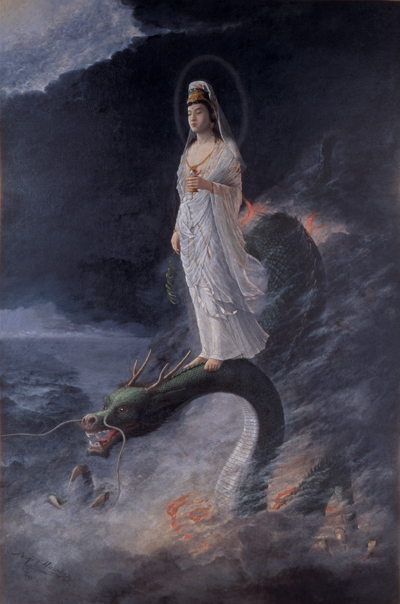
1890 (Longtime loan;coll. Gokokuji Temple)
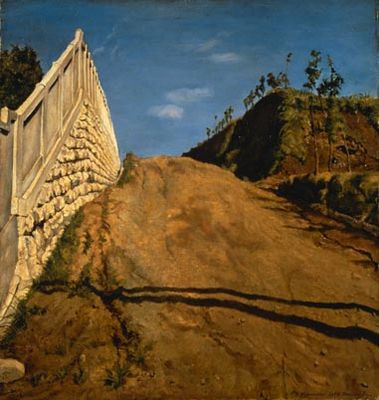
The collection at the main building of the National Museum of Modern Art, Tokyo now has thirteen pieces that are designated as Important Cultural Properties by the Japanese government, comprising eight Japanese-style paintings, four oil paintings and one sculpture.
The following Important Cultural Properties are shown in this period:
■Harada Naojiro, Kannon Bodhisattva Riding the Dragon, 1890 (Longtime loan;coll. Gokokuji Temple)
■Kishida Ryusei, Road Cut through a Hill, 1915
◆Please visit the Important Cultural Property section Masterpieces for more information about the pieces.
About the Sections
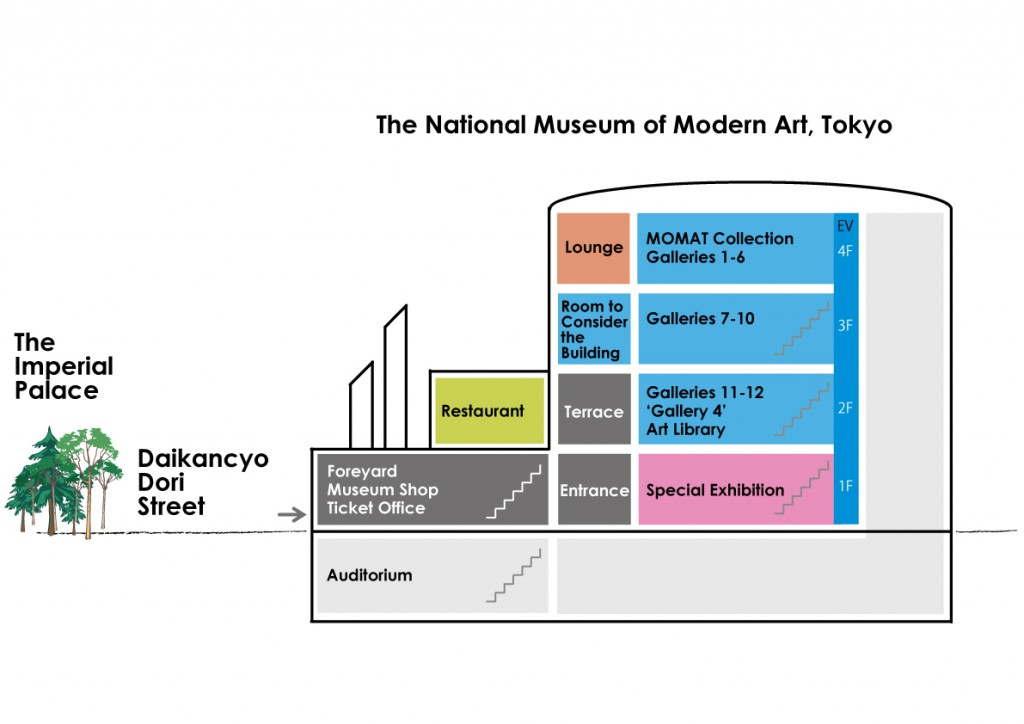
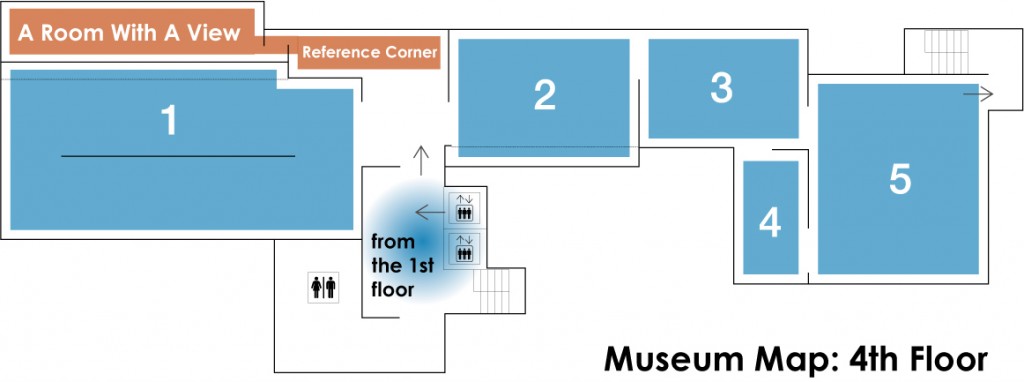
MOMAT Collection comprises twelve(or thirteen)rooms and two spaces for relaxation on three floors. In addition, sculptures are shown near the terrace on the second floor and in the front yard. The light blue areas in the cross section above make up MOMAT Collection. The space for relaxation A Room With a View is on the fourth floor.
The entrance of the collection exhibition MOMAT Collection is on the fourth floor. Please take the elevator or walk up stairs to the fourth floor from the entrance hall on the first floor.
4F (Fourth floor)

Room 1 Highlights * This section presents a consolidation of splendid works from the collection, with a focus on Master Pieces.
Room 2– 5 1900s-1940s
From the End of the Meiji Period to the Beginning of the Showa Period
A Room With A View
Reference Corner
1. Room 1 Highlights
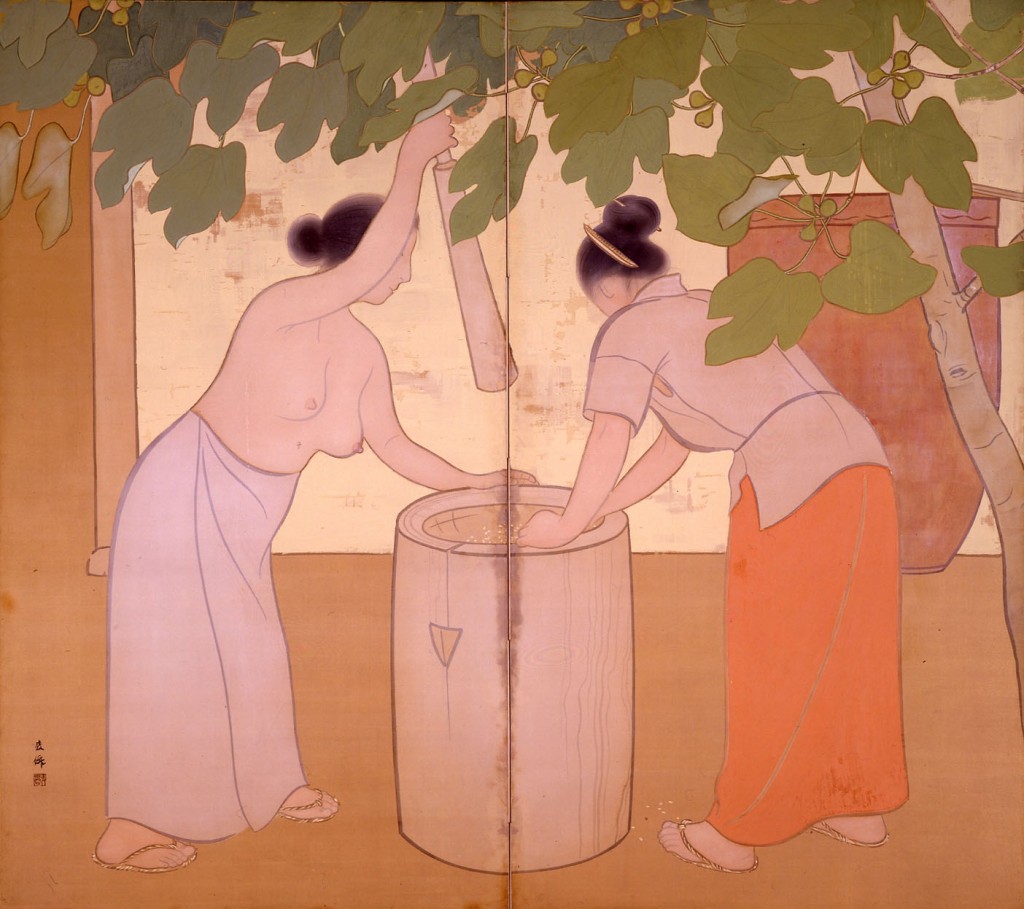
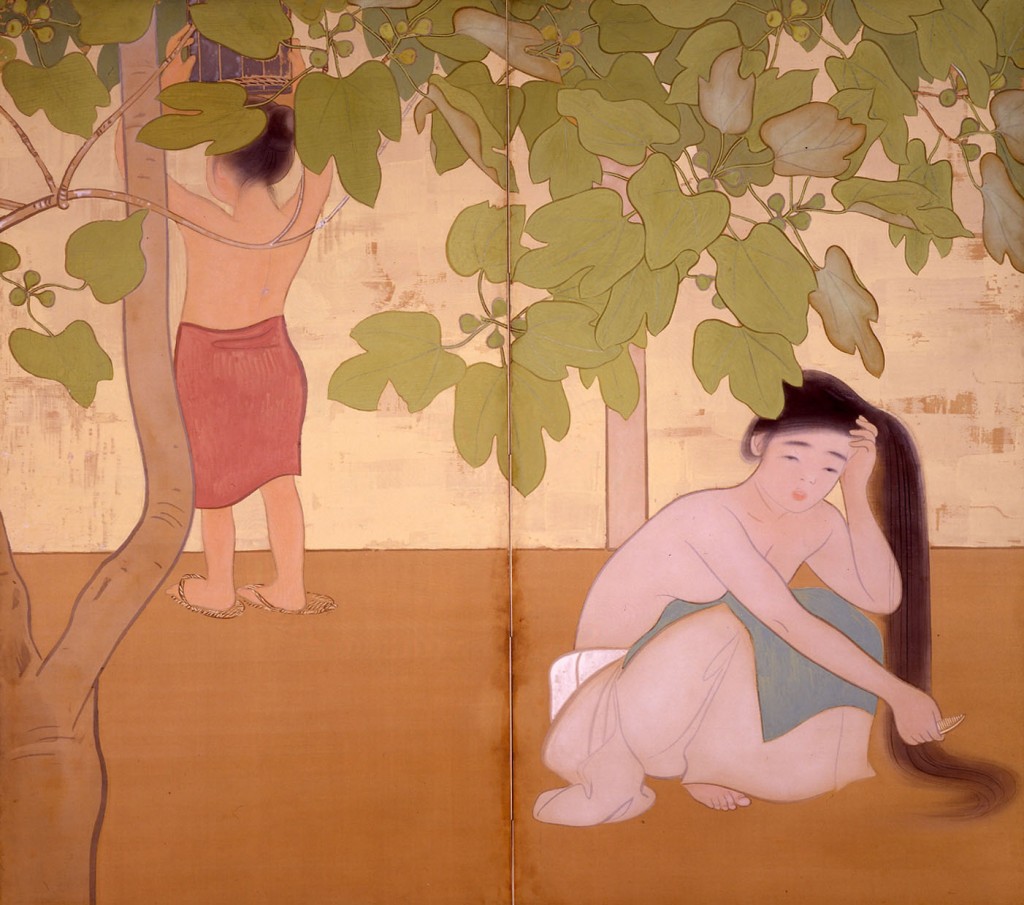
Over 200 works lined up in this 3,000-square-meter space – these extravagant conditions are the selling point of the MOMAT Collection. But in recent years, we have received an increasing number of comments like, “They’re so many things here, I’m not sure what to see!” and “All I want to do is have a quick look at the famous works in a short period of time!” Thus, in conjunction with the gallery renovation in 2012, we have created this “Highlights” corner to allow visitors to enjoy a consolidation of splendid works from the collection, with a focus on Important Cultural Properties. For the walls, we have selected navy blue to make the works stand out more beautifully. And to eliminate the glare of glass cases, we have opted for a mat black for the floor to help viewers concentrate on the displays.
In this edition of the exhibit, we start off with two folding screens that are perfect for early and midsummer: Tsuchida Bakusen’s Island Women and Kawabata Ryushi’s Flaming Grass. In addition to Important Cultural Properties by Harada Naojiro and Kishida Ryusei, the oil paintings on display include Koga Harue’s Sea. Many viewers are likely to remember this image of a woman standing erect and pointing up at the sky from their school textbooks. There is also a selection of works by foreign artists such as Pablo Picasso, Joan Miró, and Oskar Kokoschka.
2. Room 2 Proof of the Wild
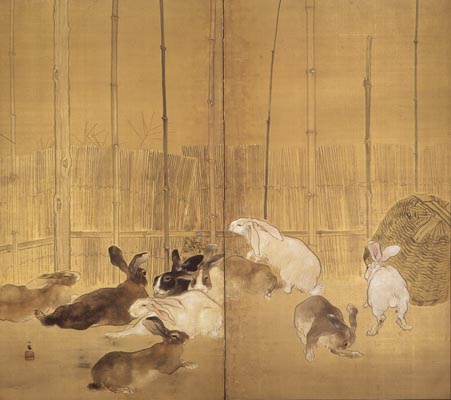
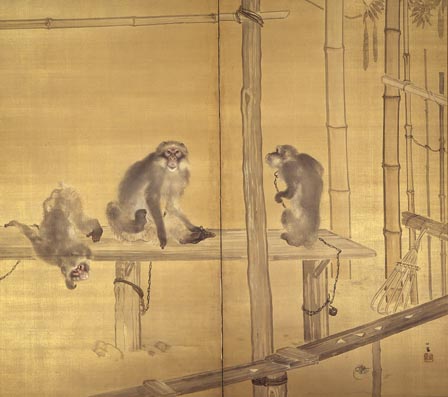
This year marks the 70th anniversary of the end of World War II. In this edition of the MOMAT Collection, we make use of the entire museum (beginning on the fourth floor and continuing down to the second floor) to present a special exhibit titled “What Are You Fighting For?” Here, we introduce approximately 200 works that are meant to inspire thought about “fighting,” including conflicts between animals, nations, men and women, and those from different generations.
In Room 2, the start of the exhibit, we have assembled a group of works dealing with animals in order to consider whether it is instinctive for living things, whether human or beast, to fight, and if so, whether it is possible to modify such behavior. In searching for works that would correspond to the theme, we discovered that the majority were made during the 1930s and ’40s – i.e., from around the time of the Second Sino-Japanese War and the Pacific War. The animals scuffle with each other, drop to the ground, and assume unfamiliar forms. When it proves difficult to clearly express their thoughts, artists often make use of a metaphorical approach . In other words, in many of the works you see here, animals are used as stand-ins for people in human conflicts.
3. Room 3 Damaged Sacred Images
In attempting to depict victims of governmental oppression and of war in a monumental way, painters often reference Christian art. Christian art includes a wide range of heartrending portrayals of martyrs that exert a direct effect on the viewer’s emotions. Images of injured people are produced to reflect the conditions of a given era – in particular around the time of Japan’s involvement in the Asia-Pacific wars. Many of these works have links to Christian art.
Ebihara Kinosuke’s Martyr depicts St. Sebastian after he was shot with a barrage of arrows. But unlike traditional icons, the arrows, which emanate from the left side of the picture, do not directly penetrate the figure, merely alluding to their merciless power. In addition to being an expression of heart-stricken grief, St. Sebastian’s unscathed body accentuates the vertical axis of the picture, and this in turn has parallels with the composition of Tsuda Seifu’s work The Victim, which was inspired by the brutal murder of the writer Kobayashi Takiji. In contrast, Kawara On uses an inverted image of a pregnant Virgin Mary in Pregnant Woman. This might also be seen as the artist’s critical view of the upright position used to honor the dead and his opposition to monumental expression.
4. Room 4 Before and After Destruction
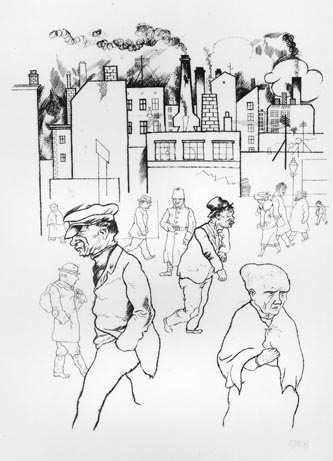
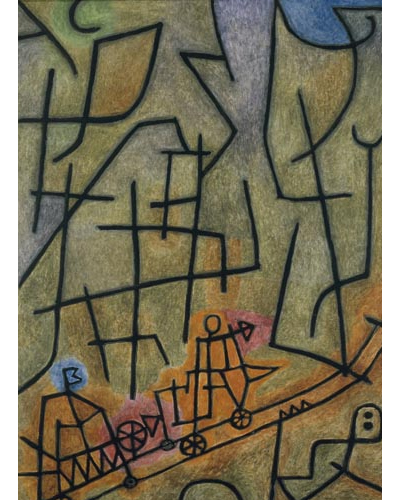
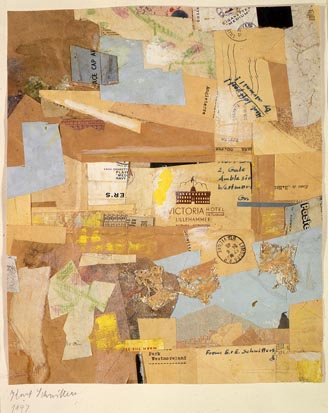
World War I, which began in 1914, not only saw the mobilization of soldiers but also those from many other fields, such as economics, science, and culture, and the start of a total war in which entire nations were enlisted as combatants. Moreover, through the advent of warplanes and tanks, and the use of weapons of mass destruction, the conditions of battle, which had traditionally involved direct combat between soldiers with bayonets and cavalries, changed greatly, resulting in unparalleled damage throughout Europe. Scenes of destruction, wrought by the arrival of modern civilization, led to a deep distrust of human reason.
This epoch of the Great War also saw the rapid rise of various movements that set out to disavow traditional values in the arts. Movements such as Cubism, which dismantled perspective, collage, which destroyed the autonomy and uniformity of pictorial space, and Dada, which functioned as a kind of “anti-art” that negated meaning, emerged in quick succession.
In this section, while comparing the work of George Grosz, Paul Klee, and Kurt Schwitters, all three of whom lived through the Great War, we focus on the close connections between innovative styles in painting and global changes brought about by the conflict, and the hallucinatory power of art that anticipated changing times.
5. Room 5 A War of the Eyes
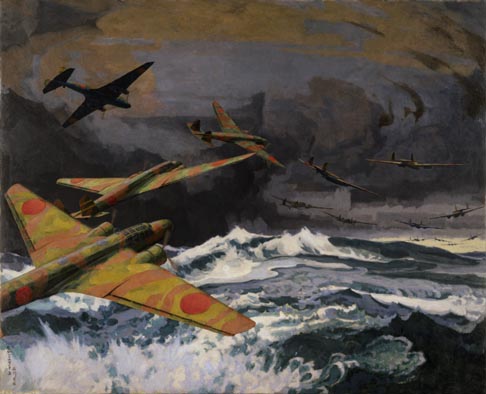
Indefinite loan
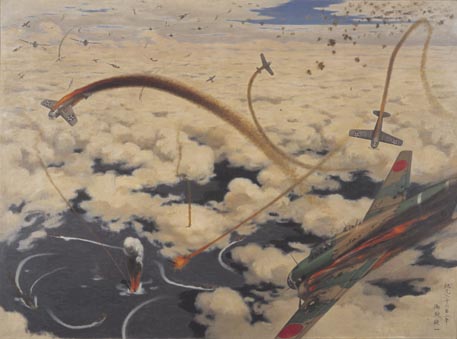
Indefinite loan
In Japan, which had played virtually no active role in the First World War, images of modern warfare involving fighter planes and tanks first came into people’s consciousness via various media during the Asia-Pacific War (i.e., the Pacific theater of World War II and the Japanese military actions leading up to it). Among these media were war campaign paintings , which still testify to the way 20th century warfare, based in miraculous new science and technology, dramatically transformed people’s visual experience.
The radically elongated horizontal format of Fujita Tsuguharu’s painting is likely rooted in the artist’s own experience with panoramic landscapes, and here serves to convey the immense horizon of the Asian continent to dramatic effect. A desire to attain a panoramic view of the landscape that would be the target of bombing led to the bird’s-eye visions that characterize bombing scenes. Japan’s aerial warfare strategy also inspired works such as Mikuriya Junichi’s dogfight scene, an attempt to render the velocity of fighter planes, and the scenes of descending paratroopers that inspired the military anthem Sora no shinpei (Sacred Soldiers of the Sky) and film of the same name. All of these are distinguished by a heroic tone against the vast expanse of the sky . They share a romantic vision of the sky that seemingly negates the miserable reality on the ground, and no doubt served to rouse a proud and pure sense of nationalism.
3F (Third floor)
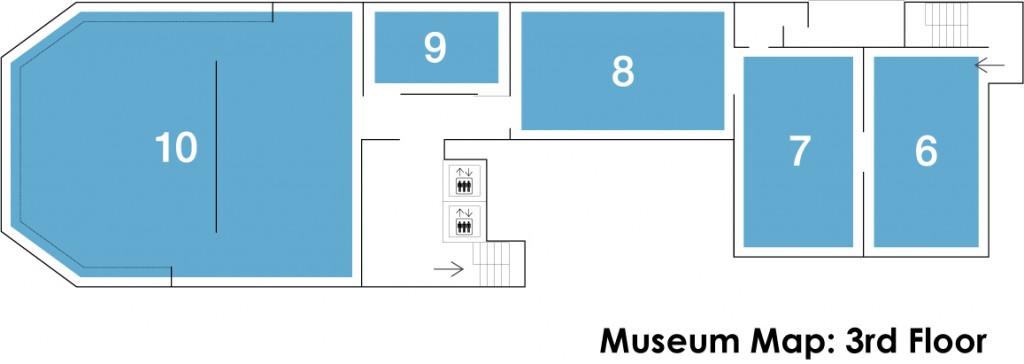
Room 6-8 1940s-1960s
From the End of the Meiji Period to the Beginning of the Showa Period
Room 9 Photography and Video
Room 10 Nihon-ga (Japanese-style Painting)
Room to Consider the Building
6. Room 6 Two War Paintings
War-record paintings were actually images from the artist’s imagination, shaped by statements from witnesses and documentary materials. If we view records in general as the result of the selection and elimination of certain events, there should be another reality not reflected in war paintings intended for public consumption. The works of Nakamura Ken’ichi, Fujita Tsuguharu, and Miyamoto Saburo shown here are all battle scenes , featuring the dramatic figures of brave fighting soldiers depicted in groups using active gestures, but they avoid gruesome, repellent imagery that might be found in a war scene. Even Fujita, who crossed the line by making a corpse the main subject of a painting, made it evident that the person had died in close combat.
After the war, painters dealt with the challenge of overcoming war paintings’ responsibility for the war. Furusawa Iwami’s Starveling, exhibited at the height of the Korean War, functioned as a parody of war paintings, presenting a montage of the actual violence that these works glossed over, and condemning Japan for once again getting involved in war. Yamashita Kikuji’s work is a report from the front lines of a conflict between landowners and tenant farmers, also employing the montage technique to examine a complex, intertwining reality from multiple angles. After the war, artists were searching for a new realism that would spark changes in reality itself.
7. Room 7 Myth of the Flame
Focusing on the theme of “ What Are You Fighting For?”, this edition of the MOMAT Collection, considers various aspects of “fighting.” In Room 7, you will find several of these. First, there is war as seen in works by Okamoto Taro, who served in the army during the Pacific War, and Madokoro Saori, who was a youth during the war. In the 1950s, the artists suddenly launched into bold artistic expressions as a challenge to the previous generation, who were responsible for the war. Okamoto, however, seems to have felt a strange and complicated attraction to tremendous power with the ability to destroy human beings, such as war and atomic bombs. Men Aflame, a work that deals with the theme of American nuclear tests, depicts nuclear power with an almost mystical sense of dread and anticipation. On the other hand, Madokoro apparently saw the mystical, something which transcended human understanding, as a woman who was the source of all things. In other words, there is another kind of conflict here, one between men and women. The video work, REAL TIMES, by Chim↑Pom, who have various links to Okamoto, addresses the artist’s ambiguous view of nuclear energy via Fukushima 2011. We can also detect a (respectful and affectionate) conflict with the previous generation in this work.
8. Room 8 Between Men and Women
The phrase “between men and women” has two different meanings. One suggests that while men and women are attracted to each other, a deep chasm exists between the two sexes, preventing them from ever completely understanding each other. The lyrics to “Song of the Black Ship” (written by the novelist Nosaka Akiyuki and released in 1971), from which this line is taken, make this abundantly clear: “Between men and women, there is a deep black river. And even though no one can ever cross the river, heave-ho! anothera nother ship will be setting sail tonight.” Because of this chasm, our attachment to the opposite sex can sometimes drive us to hurt someone, or as in the case of Kusama Yayoi, it can turn into an obsession and a source of fear.
The second meaning of the phrase suggests that we inhabit spaces that are completely cut off from each other. some people live in the undefined area between male and female . Watanabe Katsumi’s photographs, which he shot in Shinjuku during the 1960s and ’70s, depict the loneliness and pride of those who live “between men and women” in what initially appears to be a world of glamor.
9. Room 9 “Listen Quietly!”
As the shouting man here says, an incident occurred at the Japan Ground Self-Defense Force’s Camp Ichigaya on November 25, 1970. After taking the commandant hostage, the novelist Mishima Yukio attempted to rouse the troops, addressing them without a mic from the balcony of the building. But the speech, originally scheduled for a half hour, ended in only seven minutes, after which Mishima went back inside and decided to commit hara-kiri.
The artist dressed up as Mishima in this work is Morimura Yasumasa. His works are distinguished by the fact that by doing things like becoming part of a masterpiece of Western art history or turning into a famous actress, the artist (a Japanese man) raises a variety of contemporary issues such as gender, the human race, Orientalism, and real and fictional images. The important thing in the works is the “distance” between the impersonator and the impersonated. How about in this work?
Incidentally, Hosoe Eikoh’s work Ordeal by Roses, which takes Mishima as its subject, is being shown next door in Room 8.
10. Room 10 Toward the Future
Room 10 focuses on Japanese painters’ struggles with the Nihon-ga (Japanese-style painting) genre in the early postwar period. During this period, some advocated theories that Nihon-ga was dying or that it was a second-class art, and feeling a sense of crisis, painters sought out their own individual means of revolutionizing the genre. Two groups in particular made bold transformations: the Nihon-ga association Sozo Bijutsu, centered on Yoshioka Kenji and Fukuda Toyoshiro, was formed in January 1948 with the goal of creating Nihon-ga rooted in internationalism, and the Pan-Real Art Association, formed in October 1948 in Kyoto by Yamazaki Takashi, Mikami Makoto, and others. The former introduced Western elements into Nihon-ga, and the latter worked experimentally with the material properties of paint and surfaces.
The above is a textbook explanation of these Nihon-ga innovators. Looking at the actual works of art and materials, however, one realizes that the elements, such as thick paint application and abstraction, which they apparently introduced to the genre were already in use before the war, and that the artists only expanded on existing tendencies. In this sense, their efforts were part of an ongoing campaign to transform Nihon-ga, and it was just this transformation that most magazine articles and other writings on the “death of Nihon-ga” were actually advocating. What was the artists’ vision of the future? And what exactly were they grappling with, when they moved in new directions and conducted experiments that often went “too far,” inviting skepticism from both critics and the public?
2F (Second floor)
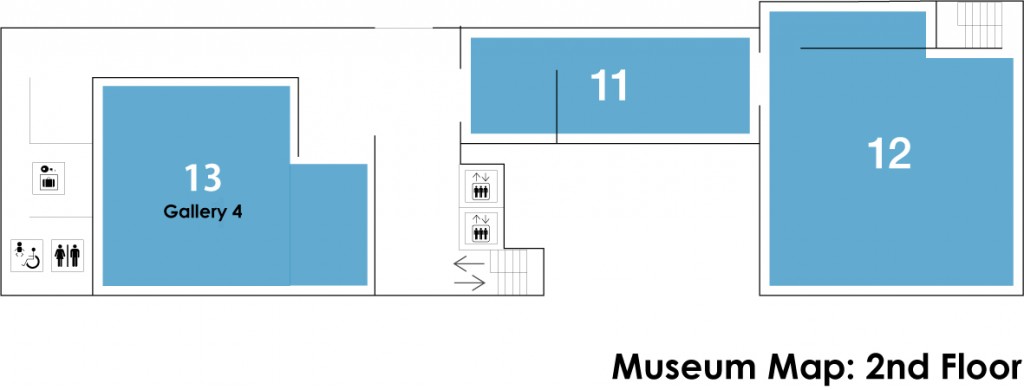
Room 11-12 1970s-2010s
From the End of the Showa Period to the Present
Gallery 4 Things: Rethinking Japanese Photography and Art in 1970s
Primarily from the Museum Collection
* A space of about 250 square meters. This gallery offers cutting-edge thematic exhibitions from the Museum Collection, and special exhibitions featuring photographs or design.
11. Room 11 The Peasants Fought!
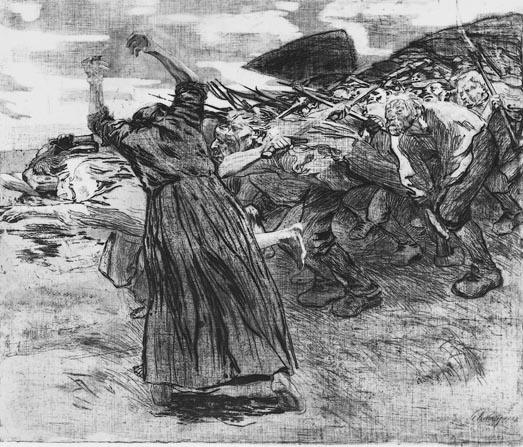
In every age, artists focus sympathetically on those who rise up and fight against adversity. Even if – or rather because – the struggle ends in failure, artists attempt to understand its significance.
Although this room is normally used to show pieces from the 1970s on, this time we present a special exhibit of all seven works in Käthe Kollwitz’ Peasants’ War, an important series from the early 20th century. This is designed to give viewers an opportunity to see the work alongside Funakoshi Yasutake’s Haranojo Castle (1971), a work dealing with the Shimabara Rebellion, the largest peasant revolt in Japanese history. And as an example from the 21st century, we present two works by the Polish artist Magdalena Abakanowicz. If the current state of affairs prohibits us from identifying the source of our oppression, and we are forced to survive without raising our voices in objection, you might say that these empty people are portraits of us.
12. Room 12 Injury Comes with a Fight
Fighting is inseparable from injury. In some cases, these injuries serve as proof of a conflict (Murakami Takashi). In other cases, after suddenly feeling a slight pain, you might come to realize how much you have fought up in the past (Leiko Ikemura). You might also find it impossible to fight against a variety of “looks” prompted by the wounds you have suffered (Ishiuchi Miyako). Or by fighting without any fear of being injured or injuring others, you might arrive at a new light (Kobayashi Masato). Human beings are creatures that are easily hurt. You might also say that it is our very vulnerability that gives us our humanity…. The philosopher Emmanuel Lévinas talked about this. He said that the fact that we naturally react to other people’s pain and that we possess a fragile body and mind that are subject to injury helps support the foundation for human society. And the reason why “vulnerability” is an important theme in contemporary art is perhaps that we tend to forget these “facts.”
About the Exhibition
- Location
-
Collection Gallery, from the fourth to second floors
- Date
-
May 26, 2015 – September 13, 2015
- Time
-
10:00 – 17:00
*Last admission is 30 minutes before closing. - Closed
-
※Closed on Mondays (except July 20) and July 21
- Admission
-
Adults ¥430 (220)
College and university students ¥130 (70)*Including the admission fee for MOMAT Collection and /Things: Rethinking Japanese Photography and Art in 1970s *The price in brackets is for the group of 20 persons or more.
*All prices include tax.
*Free for high school students, under 18, seniors(65 and over), Campus Members, MOMAT passport holder.
*Show your Membership Card of the MOMAT Supporters or the MOMAT Members to get free admission (a MOMAT Member’s Card admits two persons free).
*Persons with disability and one person accompanying them are admitted free of charge. - Free Admission Days
-
*Collection Gallery and Gallery 4
Free on June 7, July 5, August 2 and September 6 - Organized by
-
The National Museum of Modern Art, Tokyo


